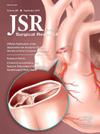Asian American Representation in Surgical Training in the United States
IF 1.7
3区 医学
Q2 SURGERY
引用次数: 0
Abstract
Introduction
Asians are considered an over-represented minority in medicine, making up 7% of the US national population but 17.1% of active physicians. However, representation trends are different across surgical specialties, and many surgical residency programs, most notably plastic surgery, otolaryngology, and orthopedic surgery, are less racially diverse than nonsurgical residency programs. Asian representation in surgical residency programs, in particular, has not been previously reported. The purpose of this study is to review demographic data among all surgical trainees to understand trends in Asian representation in surgical residency programs.
Methods
Annual Graduate Medical Education data reports were collected and retrospectively analyzed for demographic data on surgical trainees from 2013 to 2022. Sixteen surgical specialties were examined. All demographic data were self-reported. Linear regression analysis was used to examine annual trends in Asian representation over the study period.
Results
The study population included 1,296,204 resident physicians from 108,193 training programs over a 10-y study period. Of these, 350,417 (27.0%) individuals self-identified as Asian race. In fifteen out of sixteen surgical specialties, the proportion of Asian trainees was below the American Council on Graduate Medical Education (ACGME) average (P < 0.05 each). Asian representation was lowest in orthopedic surgery (12.9 ± 0.4%), surgical critical care (13.1 ± 2.2%), and pediatric surgery (15.4% ± 2.6%) (P < 0.0001 versus all programs). Only ophthalmology had a higher Asian representation (31.0 ± 1.9%, P < 0.0001) compared with the aggregate trainee population. On linear regression analysis, Asian representation has declined among total ACGME-accredited programs at a rate of 0.2% annually (R2 = 0.82, P < 0.0001). Seven surgical specialties experienced an annual decline in Asian representation over the past decade, including cardiothoracic surgery (traditional), colorectal surgery, complex general surgical oncology, general surgery, ophthalmology, plastic surgery (traditional), and vascular surgery (traditional) (P < 0.05 each). Similar trends in representation are reported among the current surgical workforce.
Conclusions
The percentage of Asians in almost all surgical residency training programs falls below the ACGME average, indicating low matriculation rates into surgical specialties. Trend analysis suggests that these disparities have only grown wider over the past decade. Future initiatives should focus on recruitment and mentorship of Asians surgeons, in order to best care for the large and growing Asian demographic in the United States.
亚裔美国人在美国外科培训中的代表性
亚洲人被认为是医学界代表性过高的少数民族,占美国全国人口的7%,但占在职医生的17.1%。然而,不同外科专业的代表性趋势是不同的,许多外科住院医师项目,尤其是整形外科、耳鼻喉科和整形外科,比非外科住院医师项目的种族多样性要少。尤其是亚洲人在外科住院医师项目中的代表性,以前没有报道过。本研究的目的是回顾所有外科培训生的人口统计数据,以了解亚洲人在外科住院医师项目中的代表性趋势。方法收集2013 - 2022年年度研究生医学教育数据报告,回顾性分析2013 - 2022年外科培训生的人口学资料。调查了16个外科专科。所有人口统计数据均为自我报告。线性回归分析用于检查亚洲代表性在研究期间的年度趋势。结果在10年的研究期间,研究人群包括来自108,193个培训项目的1,296,204名住院医师。其中,350,417人(27.0%)自认为是亚洲种族。在16个外科专科中的15个专科中,亚洲实习生的比例低于美国研究生医学教育委员会(ACGME)的平均水平(P < 0.05)。亚洲患者在骨科(12.9±0.4%)、外科重症监护(13.1±2.2%)和儿科外科(15.4%±2.6%)中的比例最低(与所有项目相比P <; 0.0001)。只有眼科的亚洲人比例高于总受训人数(31.0±1.9%,P < 0.0001)。在线性回归分析中,亚洲代表在acgme认证的项目中以每年0.2%的速度下降(R2 = 0.82, P < 0.0001)。在过去的十年里,亚洲人在7个外科专科的比例逐年下降,包括心胸外科(传统)、结直肠外科、复杂的普通外科肿瘤学、普通外科、眼科、整形外科(传统)和血管外科(传统)(各P <; 0.05)。在目前的外科工作人员中,报告了类似的代表性趋势。在几乎所有外科住院医师培训项目中,亚洲人的比例低于ACGME的平均水平,这表明进入外科专业的入学率很低。趋势分析表明,这些差距在过去十年中只会越来越大。未来的举措应侧重于招募和指导亚洲外科医生,以最好地照顾美国庞大且不断增长的亚洲人口。
本文章由计算机程序翻译,如有差异,请以英文原文为准。
求助全文
约1分钟内获得全文
求助全文
来源期刊
CiteScore
3.90
自引率
4.50%
发文量
627
审稿时长
138 days
期刊介绍:
The Journal of Surgical Research: Clinical and Laboratory Investigation publishes original articles concerned with clinical and laboratory investigations relevant to surgical practice and teaching. The journal emphasizes reports of clinical investigations or fundamental research bearing directly on surgical management that will be of general interest to a broad range of surgeons and surgical researchers. The articles presented need not have been the products of surgeons or of surgical laboratories.
The Journal of Surgical Research also features review articles and special articles relating to educational, research, or social issues of interest to the academic surgical community.

 求助内容:
求助内容: 应助结果提醒方式:
应助结果提醒方式:


